Ich weiß nicht mehr genau, wie alt ich war, vielleicht 15 oder 16,als ich die Erzählung "Der Garten der Steine" von Daniil Granin las. Ein Bericht über einen Garten mit 15 Steinen, so angeordnet, dass der Betrachter immer nur 14 davon auf einmal erblicken kann. Was wie eine simple Mathematikaufgabe erscheint, wenn man es von Ferne betrachtet, ist ein großes Faszinosum wenn man davor steht.
Der Garten der Steine ist der bekannteste Zen Garten Japans, vielleicht die Materialisierung des Zen überhaupt. Der Garten ist Bestandteil des Ryoan-ji, des Tempels des zur Ruhe gekommenen Drachens, im Norden Kyotos. Der Tempel wurde im Jahr 1450 von einem Staatsbeamten auf dem ehemaligen Landsitz einer Adelsfamilie angelegt und gehört seit 1994 zum Weltkulturerbe der UNESCO.
Auf dem Tempelgelände gibt es einen See mit einer kleinen Insel und einem Shinto-Schrein. Beides ist typisch für sakrale Anlagen in Japan, das fließende Wasser, das man in nahezu allen Gärten und Parks antrifft, ein Symbol für die Reinheit (siehe Miyajima, der Schrein im Wasser) und der Synkretismus zwischen den beiden großen Religionen, dem Buddhismus und Shintoismus.
Ein großer Buddha und eine kleiner Wegweiser zeigen an, wo es lang geht, dann betrete ich den Tempel und offeriere der Dame am Empfang meine Eintrittskarte, den entgegen meiner ursprünglichen Annahme, ist der Besuch in den Tempeln und Schreinen hier nicht kostenfrei sondern kostenintensiv. Sie stempelt mein Ticket und verordnet mir ein Paar Pantoffeln. Chic in beige, Einheitsgrösse, passt nicht allen, und für die Kinder gibts die in klein mit Miffi drauf. Nun können wir es uns gemütlich machen, und das eigentliche Tempelgebäude besuchen. Ein großer Raum, teilbar durch Schiebetüren und Stellwände, die geschlossen den ruhenden Drachen abbilden.
Vor dem Haus eine kleine dreistufige Terrasse, und da ist er - der steinerne Garten. Ein Geviert,10 mal 30 Meter, gerechter Kies, fünf Gruppen verschieden großer Steine auf bemoostem Grund, scheinbar zufällig plaziert und ...ZEN. Viele Besucher sitzen auf der Terrasse und beobachten die vollkommen entspannte Stille, die über dem Garten liegt. Gut, dass es Winter und zudem kalt war, ich säße heute noch dort...Ich bin nun schon viel und weit gereist, und doch bin ich manchmal völlig fasziniert davon, dass ich nun Orte besuchen kann, die einst weiter weg waren, als der Mond am Himmel. Welch ein Geschenk.
Anschließend umrunde ich erst den Tempel, dann den See, an einer kleinen weißen buddhistischen Pagode und vielen bemoosten Steinen vorbei und komme dann auf die Hauptstraße zurück und die Wirklichkeit erscheint einen Moment lang unwirklich.
Also, Musik ins Ohr, heute gibt es Bach und ich wandere so an der Straße entlang, mal sehen, ob es noch was zu sehen gibt, bevor die nächste Bushaltestelle kommt.
Es gibt. Unweit des kleinen, eher gemütlichen "Ruhenden Drachen" erstreckt sich ein riesiger buddhistischer Tempelkomplex. Der Bau der Anlage begann im Jahr 888 auf Befehl des Kaisers, der sich auch nach seiner Abdankung hierher zurückzog und als Mönch lebte. Bis zur Meiji Zeit war der Tempel Zentrum prokaiserlicher Kräfte und Ursprung des esoterischen Buddhismus in Japan.
Die meisten Gebäude stammen aus dem 17.-19. Jahrhundert und sind somit Replike der Originalbauten, die im Laufe der Geschichte Feuer, Sturm und Erdbeben zum Opfer fielen.
Die große Kondo-Halle und die Pagode gehören zu den nationalen Kulturgütern Japans und natürlich zum Weltkulturerbe. Da immer noch Feiertag ist, sind auch hier alle Gebäude bis auf zwei geschlossen.
Auch gibt es viele Kirschbäume auf dem Gelände, eine besondere Art, die keinen Stamm hat, und deren Zeige sich bereits kurz über dem Boden zu eine Krone verbreiten. Im Frühling müssen diese fast weiß blühenden Bäume wie riesige Schneebälle aussehen.
Apropos Schnee, es schneit und die Sonne geht unter und der Tempel wird in 20 Minuten geschlossen und ja, ich habe verstanden, bin schon weg.
Am Busbahnhof angekommen, zeigt mir der Geldautomat an, dass der Feiertag vorbei ist und er seinen Dienst wieder aufgenommen hat. Ich stand bestimmt drei Minuten da und bestaunte das Geld, das ich in der Hand hielt und die Japaner haben gesehen, was sie schon immer wussten, die spinnen, die Ausländer...
Don´t know, how old I was, maybe 15 or 16, when I was reading the novell "The Garden Of Stones" by Daniil Granin. A story about a garden with 15 stones, arranged in the way that one can only see 14 at the same time. What looks like a simple math task if one look from far away, is something totally faszinating if one stands right in front of it.
The garden of stones is the most famous Zen garden in Japan, maybe the materialisation of Zen at all. The garden belongs to the Ryoan-ji, the temple of the resting dragon in the north of Kyoto. The temple was build in 1450 by a state offical at a former country estate of a noble family and belongs to the world cultural heritage of the UNESCO since 1994.
On the temple area is a small lake with an artifical island wich houses a Shinto shrine. Both is typical for sacral sites in Japan. There is always floating water, wich is to find in nearly all of the gardens and parks, a symbol of purity (see also Miyajima, the shrine in the water) and the syncretism between the both religions, buddhism and shintoism.
A big buddha and a small sign show the way and than I enter the temple and offer the lady at the counter my ticket, against my primary idea is the visit of temples and shrines in Kyoto not for free, but for money. She stamps my ticket and provides my a pair of slippers. Chic, beige, one-size-doesn´t-fit-all, for the kids they are in small with Miffi on it. Now we can make it cozy for ourselfs and enter the temple, a very large room, separeted by slide doors and paravents, wich show a resting dragon when closed.
In front of the house a three steps terrace and there it is - the stony garden, a quad, 10 by 30 metres, raked pebbles, an 15 stones in five groups on mossy ground, seemingly randomwise placed and ....ZEN. A lot of visitors are sitting at the steps and watch the perfect relaxed silence wich exceed over the garden. Thanks, it´s winter and cold, otherwise I still would sit there... Up to now, I traveled far and often, but sometimes I´m a bit overwhelmed that I can visit places now, wich very more far away than the moon in the sky in former times. What a precious gift.
Then I surround the temple and the lake, pass a small white buddhistic pagoda and a lot of mossy stones and get back to the main road and reality is unreal for a short moment.
Than, music in the ears, today it´s Bach and I´m strolling along the street to find out if there is something to find out before I find the next bus stop.
And yes, there is. Very near the more cosy resting dragon is a huge buddhistic temple complex. Build back in 888 by the emporer, who stayed there as a monk after abdication. Until the Meiji time it was the center of the pro imperial forces and the origin of the esoteric buddhism in Japan.
The most of the buildings are from the 17th to 19th century and are replicas of the original ones, wich were destroyed by fire, storm and earthquake several times.
The big Kondo Hall and the pagoda belong to the national cultural treasures of Japan and of course to the world cultural heritage. It´s still holiday and all the house, except two are closed.
There are a lot of cherry trees here, wich are special, because there is now trunk, and the twigs start to form a crown near the ground, so when the bloom, they must look like giant snow balls.
Apropos snow, here it is, big wet snow flakes, sunset and the temple will close in 20 minutes, ok. I get it, I´m off for now.
Arriving at the bus station I see that the ATM finished the day off and is on duty again and I stand there for about three minutes staring at the money in my hand and the Japanese see what they have had known for all the time, these gaijin are crazy....




















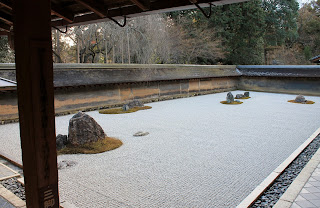



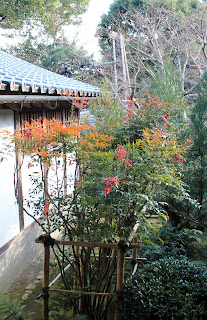














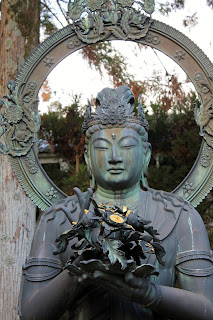

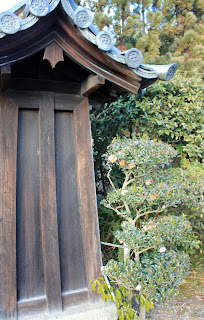

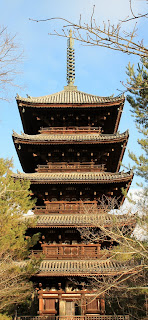












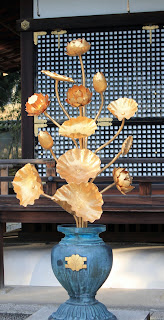










Keine Kommentare:
Kommentar veröffentlichen